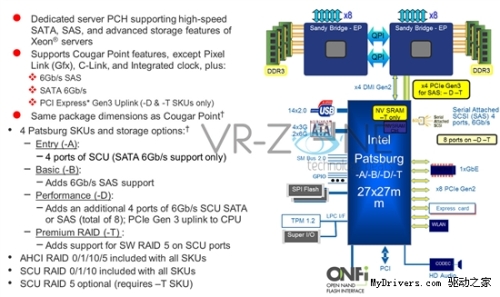 Not long ago there was news that Intel's next-generation Sandy Bridge-E high-end platform will be postponed from the fourth quarter of this year until January next year, and the latest news that Intel is still very hard to strive to release a new platform during the year.
Not long ago there was news that Intel's next-generation Sandy Bridge-E high-end platform will be postponed from the fourth quarter of this year until January next year, and the latest news that Intel is still very hard to strive to release a new platform during the year. The reason why Sandy Bridge-E may not be released on time is not related to the opponent. Instead, Intel has encountered several problems involving storage, PCI-E, and even stepping versions of the processor itself. There are many bad news.
The figure below shows the architecture specifications of the server version Sandy Bridge-EP and its chipset Patsburg, mainly in terms of storage. The consumer-grade versions of Sandy Bridge-E and X79 are similar to those of the former, except that the features have been streamlined. In particular, the processor does not support two-way parallelism.
There are four Patsburg-A/B/D/T server chipsets, while the consumer-grade X79 chipset is code-named Patsburg-X. All of them support AHCI RAID 0/1/10/5, SCU RAID 0/1/10, and the package area is 27 x 27mm, which is the same as the existing Cougar Point 6 series chipset.
The 6 Series chipset supports up to two SATA 6Gbps, four SATA 3Gbps interfaces, Patsburg will upgrade on this basis: entry-level Patsburg-A increased to six SATA 6Gbps, Patsburg-B added support for SAS 6Gbps, high-performance Patsburg-D continues to increase the number of SATA/SAS 6 Gbps interfaces to ten, with a dedicated PCI-E 3.0 x4 storage channel between the processors, while the top Patsburg-T continues to add software RAID 5.
The Patsburg-X should have been the same as the Patsburg-D, but did not know why Intel decided to downgrade it to the level of Patsburg-B, which means it lost four SATA/SAS 6Gbps interfaces (the remaining six SATA/SAS 6Gbps and Four SATA 3Gbps) and there is no PCI-E 3.0 x4 channel between processors.
Sandy Bridge-E should have been the first Intel platform to natively support the PCI-E 3.0 specification, but it has not been very smooth. Because of the lack of hardware for compatibility testing, Intel has decided to cancel support for PCI-E 3.0 on Sandy Bridge-E, and may try to join it after releasing it.
Of course, there is no PCI-E 3.0 expansion card, especially the graphics card, so the LGA2011 Sandy Bridge-E platform does not support this norm, but the new platform should stick to the second half of 2013. Certainly there will be a lot of PCI-E 3.0 expansion cards available, it is not very good.
The C0 stepping version of the Sandy Bridge-E processor should have been shipped to partners for test verification in the next 2-4 weeks, but Intel decided to re-create the C1 version. The good news is that there is no problem with the corresponding motherboard design specifications. The current X79 motherboard samples do not need to be redesigned, except for the simplification of the SATA/SAS interface.
Whether Sandy Bridge-E will speak at the end of this year or next year will depend on Intel's speed in solving this problem.
Signal Booster,Signal Repeater,Gsm Repeater
Fuzhixing Electronics Co., Ltd. , http://www.gdsignalbooster.com